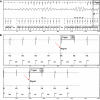Appropriate Delivery of Antitachyarrhythmia Therapy Despite Magnet Placement Over Implanted Cardioverter-Defibrillator: A Case Report
- PMID: 33999010
- PMCID: PMC8162221
- DOI: 10.1213/XAA.0000000000001465
Appropriate Delivery of Antitachyarrhythmia Therapy Despite Magnet Placement Over Implanted Cardioverter-Defibrillator: A Case Report
Abstract
The fundamental perioperative concern for patients with implantable cardioverter-defibrillators (ICDs) is the potential for electromagnetic interference (EMI) from monopolar electrosurgery. The ICD may interpret electromagnetic signals as a tachyarrhythmia and deliver an inappropriate shock to the patient. Magnet placement is often used to avoid this problem since a magnet will often deactivate an ICD's tachyarrhythmia therapy. We report a case in which magnet placement over an ICD failed to suspend tachyarrhythmia therapy because of imprecise magnet positioning. This case demonstrates the possibility for error when relying on a magnet to suspend tachyarrhythmia therapies.
Copyright © 2021 The Author(s). Published by Wolters Kluwer Health, Inc. on behalf of the International Anesthesia Research Society.
Conflict of interest statement
The authors declare no conflicts of interest.
Figures


References
-
- Schulman PM, Rozner MA. Case report: use caution when applying magnets to pacemakers or defibrillators for surgery. Anesth Analg. 2013;117:422–427. - PubMed
-
- Goel V, Shankar H, Mulpuru SK, Ramakrishna H. Inappropriate defibrillator shocks during cervical medial branch radiofrequency ablation: a case report. A A Pract. 2020;14:e01286. - PubMed
-
- McFaul CM, Lombaard S, Arora V, Van Cleve WC, Rooke GA, Prutkin JM. Unexpected shocks from a subcutaneous implantable cardioverter-defibrillator despite attempted reprogramming and magnet use: a case report. A A Pract. 2020;14:e01178. - PubMed
-
- Streckenbach SC, Benedetto WJ, Fitzsimons MG. Implantable cardioverter-defibrillator shock delivered during electroconvulsive therapy despite magnet application: a case report. A A Pract. 2020;14:e01284. - PubMed
-
- Römers H, VAN Dijk V, Balt J. Erroneous magnet positioning leads to failure of inhibition of inappropriate shock during fast conducting atrial fibrillation episodes. Pacing Clin Electrophysiol. 2017;40:741–743. - PubMed
Publication types
MeSH terms
LinkOut - more resources
Full Text Sources
Other Literature Sources
Medical

